|
|
|
|
Products mentioned in this Article
--None--
|
|
|
|
|
|
|
|
|
 |
|
|
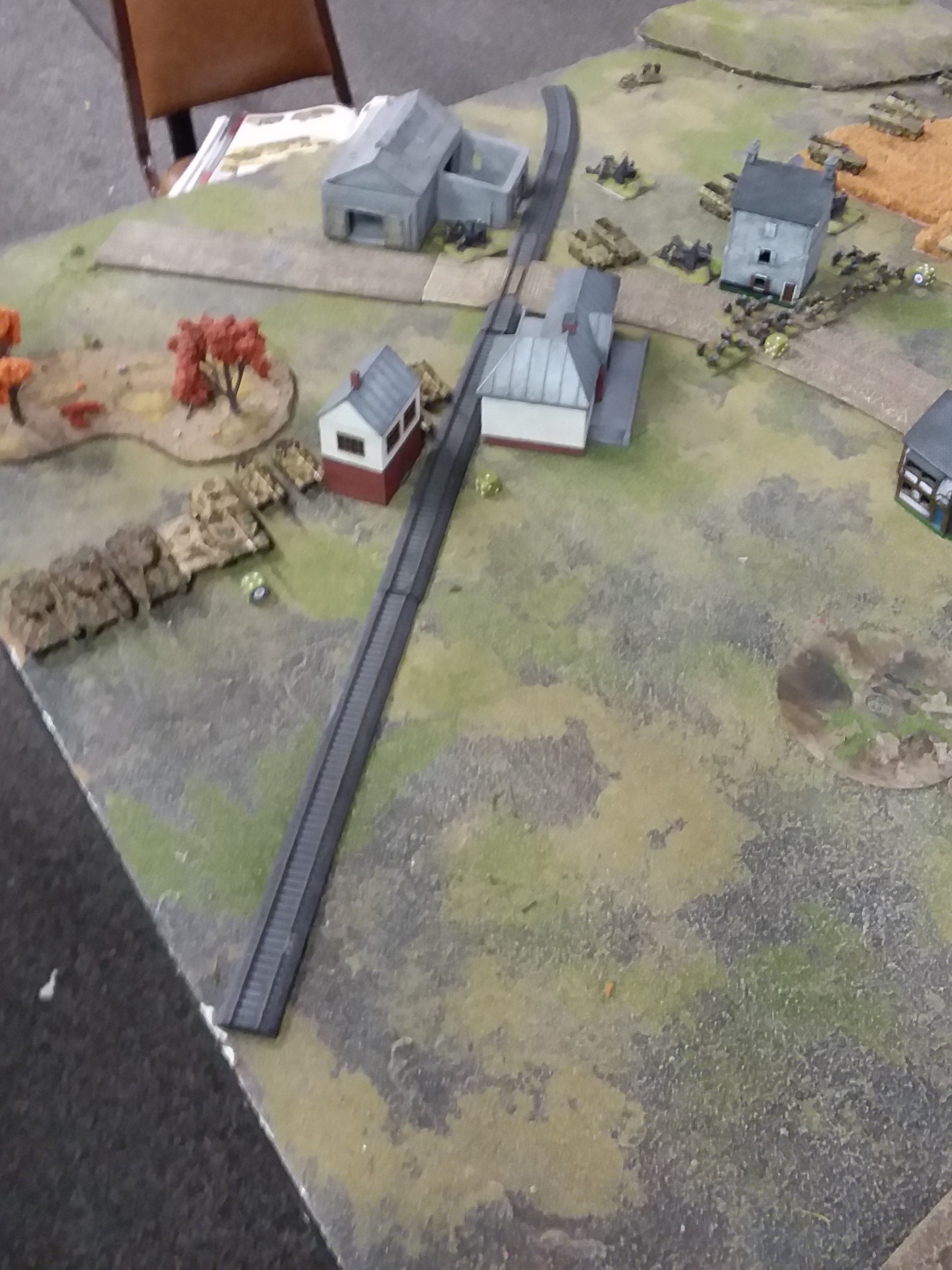 |
Firestorm Kursk: Phase III – Operation Rumyantsvev
with Jim Naughton
After a week-long break for America’s Memorial Day holiday, the campaign continued. The holiday schedule precluded the two senior leaders from meeting, so I rolled electronic dice and corresponded with them by e-mail. The dice produced Battle Arrows 1, 3, and 4 as German-controlled while 2 and 5 were Soviet-controlled. The strategic situation was pretty grim for the Germans thanks to the Russians capitalizing on three Battle Arrows in Phase I. The Soviets controlled 30 VPs and had posted two victories in Tank Battles. FM Zeitzler (TimH) allocated an attack to recover Belgorod from Voronezh Front (Arrow 1) and followed with attacks from the German Base Area to recover Briansk and Orel. Tim’s strategy was to reduce the Russian VP total as far as possible while avoiding a loss in Prokhorovka, which would increase the Soviet victory level. Jim H placed an attack from Sudska to Oboyan to destroy the remaining German penetration, and placed a Tank Battle Marker in Prokhorovka.
|
|
The Red Tide was in on the first night. Rob N brought his American armored rifles and defended against Rob G in Breakthrough at 150 points. The American infantry prevented the Germans from seizing either objective. A lot of steam came out of the German attack when an M10 ambush wrecked the Ferdinand. The real disaster was when a reinforcing panzer grenadier platoon failed in its initial assault on another American infantry outfit covering the deep objective. Despite favorable position, it was repulsed, and then failed five saves in a row from American fire. With several units now facing last stand checks and the company almost broken Rob G resigned. 8-1 Soviets; and this time the Soviets capitalized on the enemy failure, gaining Kharkov.
|
|
Ben I’s mixed tankovy with a scout car company, in effect a Forward Detachment, took on Rick B’s panzer grenadiers with Rick as the ATTACKER in COUNTERATTACK. The prize was a Tank Battle victory in the Prokhorovka track. The resulting slugging match went on for turn after turn as Rick slowly whittled away at Ben’s force. Ultimately Rich’s Marders and Stukas won the battle by controlling an objective. 7-2 Germans with the Germans gaining a VP on the Prokhorovka track and denying an improved victory level for the Soviets.
Jim H defeated Tim M in the struggle to maintain the German penetration into Oboyan. Jim H’s mixed tankovy fared better than BenI’s despite deploying a similar force, thanks to being the Attacker in Bridgehead. Jim crushed the German bridgehead over the Donetz by massing on one flank and driving into the German rear, overwhelming Tim’s panzer grenadiers. 8-1 Soviets
|
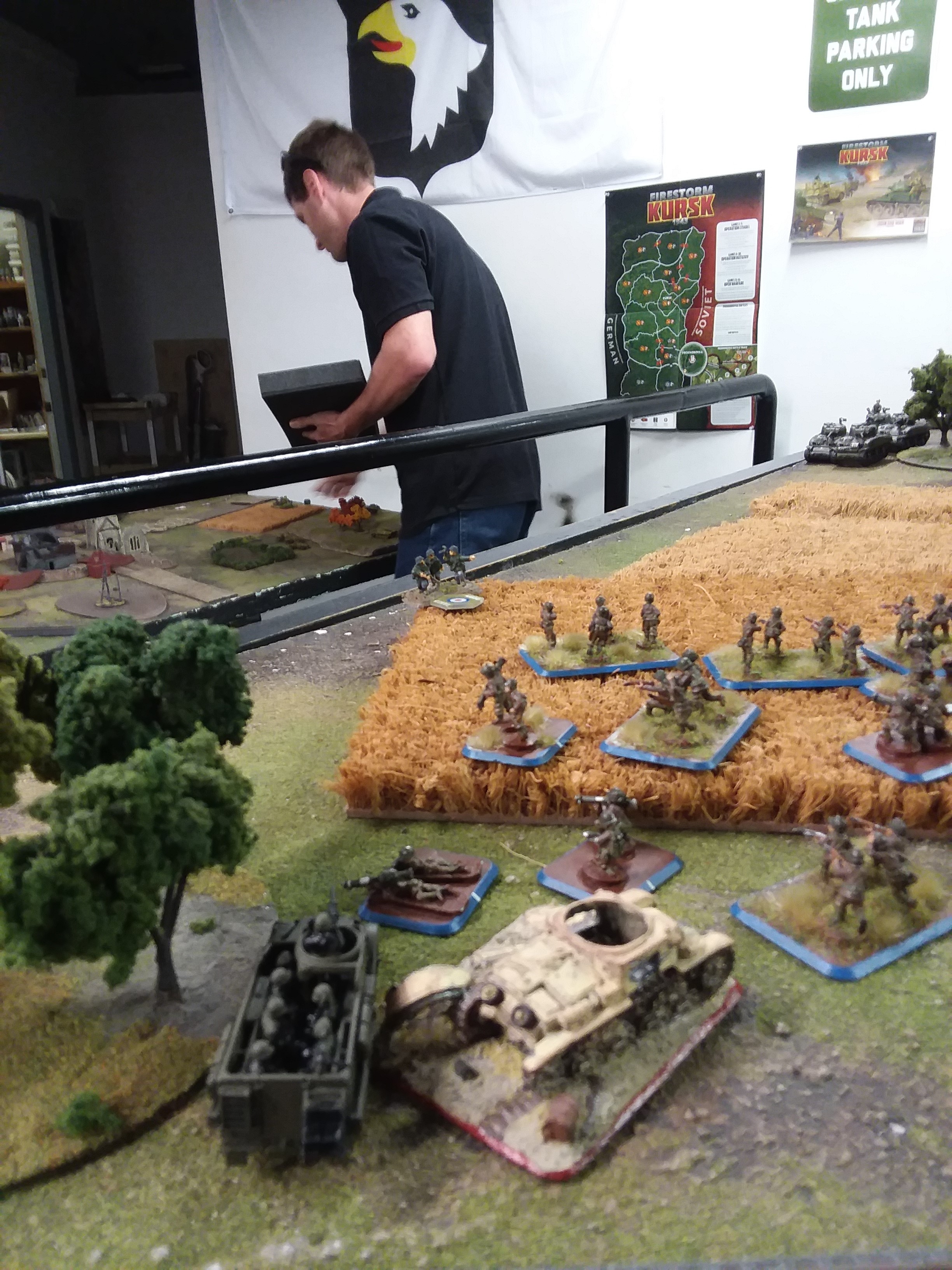 |
|
Finally, I faced Tim M in a second battle, playing Dust Up. My veteran Sturmoviks managed to kill only one Marder and my tanks were late, putting the battle on the shoulders of both sides’ infantry. The Razvedki and their M3 scout car transport proved equal to panzer grenadiers, with both sides wiping out a platoon. Tim’s effective use of his Marders and an 88 kept my reinforcements away from a key objective, but my KV-8s managed to drive his infantry away from a key building. The battle turned on a freakish attack by a single KV-8 that passed one cross check, shook off six hits from Stummels, and assaulted his company headquarters, destroying it (having to roll 5+ no less than 4 times to achieve this result). 6-3, Soviets, denying Briansk to the German counteroffensive.
Two more weeks went by before we completed the final battles for the campaign. The delay was brought on by the LATE WAR roll-out with our own mini-tournament preempting Kursk on June 8th. The last battles were fought on June 14th with Oil Wars-TY and Late War games competing for attention.
|
|
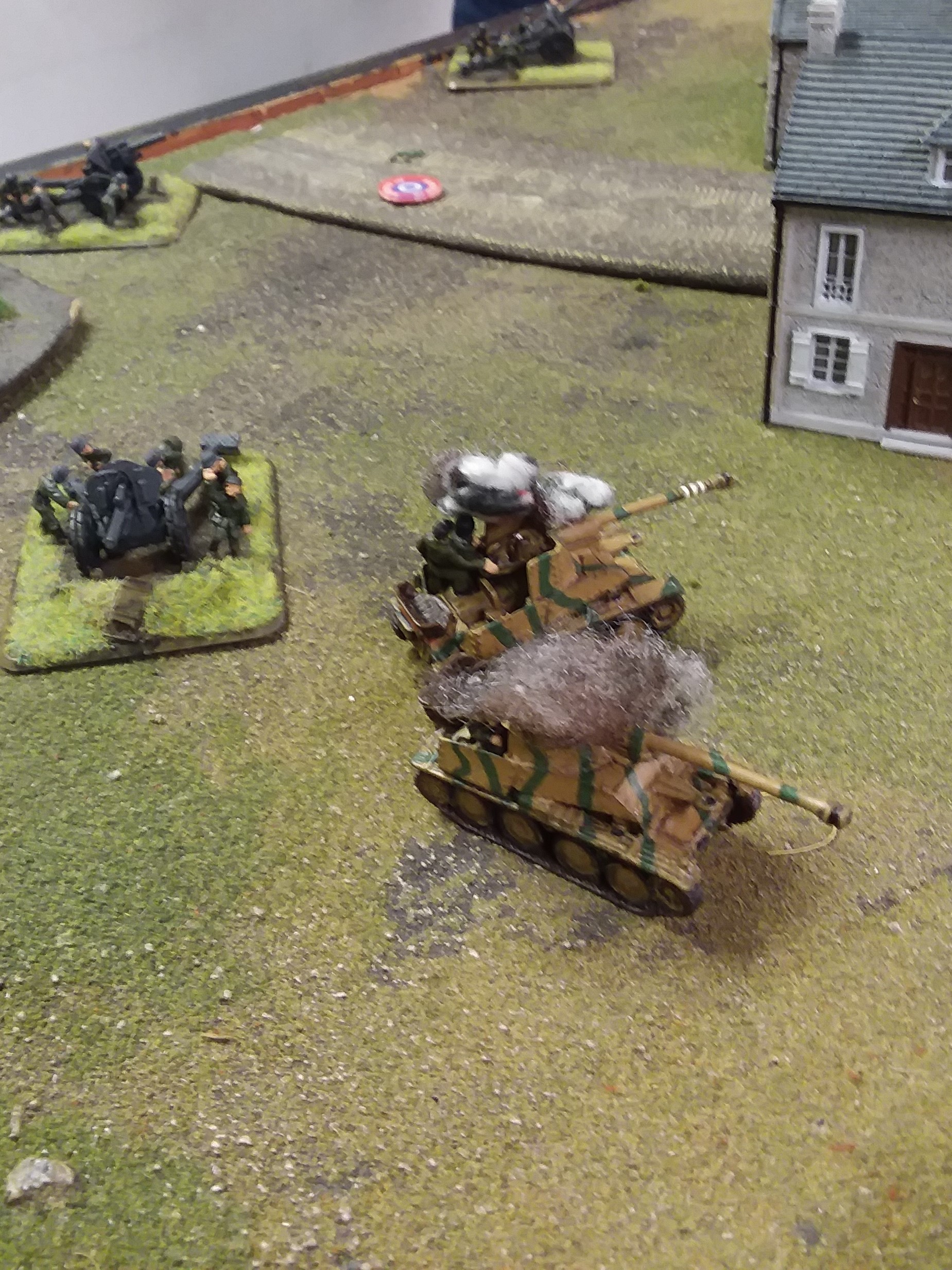
|
I first faced Rob G who deployed a panzergrenadier company with Panthers, Marders, and Ferdinand in support. This was Battle Arrow 4, the German attack into Orel, and saw a German Attack battle plan face off against Soviet Defend resulting in NO RETREAT. My force of a Hero Motor Rifle Battalion and a BA-10 company supported by a T34 company and a Guards Churchill company plus SU122s as well as veteran Sturmoviks proved too tough. Rob placed his objective on the eastern side of the table while I placed mine deep on the west. I protected the ‘near’ objectives with a belt of five minefields connecting buildings together. Rob G attempted to attack through a mine belt on the eastern side of the battlefield with infantry supported by a couple Grilles. The central spine of the table included a modest village, and I used this a maneuver screen to bring my BA-10s to bear on his infantry. Both infantry platoons were pinned and only one recovered in his next turn. On turn 3 Rob managed an assault against a machinegun position and was repulsed.
|
|
The western end of the battlefield saw Rob initially open fire at the rifle battalions 76mm antitank guns. Rob managed to kill two on turn 1, encouraging an attempt to move forward into a developing gap on that flank. He finished off the 76mm guns on turn 2. On my turn 2 I dropped my T34s from ambush into the central town, flanking his Panthers. A devastating volley from the T34s eliminated the platoon. Counter fire from Marders and his Ferdinand knocked out two of the offending T34s, but my Churchills arrived from reserve, and occupied the objective on the west side of the table. Rob resigned, 8-1 Soviets.
|
|
We also had an ‘extra’ battle played in Prokhorovka, when the Soviets controlled the ‘extra’ arrow. MikeS and I played, and as it was Prokhorovka, both of us chose Attack. We ended up in FREE-FOR-ALL. Mike was running a MKIII company with a Ferdinand and Marders plus Stuka for support, and I had a T34 battalion including Valentines plus a Razvedki company with KV-1s, BA-10s, and SU-122 for support. Mike gambled and left his western objective ungarrisoned, counting on a river to prevent my forces from getting there. I encouraged this by placing most of my troops so they appeared to threaten his center and eastern objective.
The battle developed into a slugfest on the eastern sector and in the center, with the loss of 4 Valentines, 1 T34, and 6 scout cars of various flavors balanced against 4 MKIII. But the game turned on a pinning attack by 3 KV-1s in the center while I carefully prepared a 36” dash move by 2 M3 scout cars with 3 infantry stands along a road placing them on the unoccupied objective. Mike’s Stuka proved to have engine problems, never showing up in five turns, and most particularly not showing up on the last turn to destroy the scout car raid. 7-2 victory, Soviets.
|
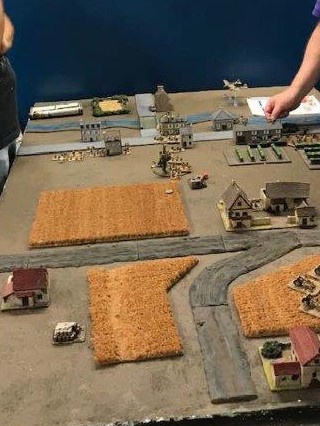
|
|
The 2nd Panzer Army and 9th Army desperately tried to restore the original front lines on the northern flank of the Kursk battlefield but fresh Soviet formations easily handled these counterattacks while the Tank Corps refueled to continue the drive west to Smolensk. Meanwhile, 4th Panzer Army tried to reestablish supply connections to its beleaguered spearheads in Oboyan only to have a riposte from a refueled and rested 1st Tank Army slice behind them and reoccupy Kharkov. 5th Tank Army final drove the last of 4th Panzer Army and Army Detachment Kemph over the Donetz, ending the fight for Prokhorovka. Marshall of the Soviet Union Zhukov unleashed Malinkovski’s Southwest Front in Operation Rumyantsvev , forcing a general retreat on the southern sector.
Hitler put an end to further offensive operations after the remnants of XLVIII Panzerkorps effected a breakout southeast, linking up with the II SS Panzerkorps. XXIV Panzerkorps was diverted to support 1st Panzer Army, and Liebstandarte Adolph Hitler was diverted to Italy to refit and stabilize the deteriorating political situation there. With his flanks crumbling, von Manstein had no choice but to go over to the defensive and extract his armored spearheads from peril. After 23 days of hard fighting, the Germans had lost key cities and the Kursk pocket was serving as a springboard for deeper penetrations in Axis-held Russia.
|
|
Campagin Outcome
The first campaign round producing 3 Soviet attacks put the Germans in a hole from which they never recovered. The Soviets always had enough attacks to cut off the narrow German penetrations preventing the Germans from getting to high value targets. The second phase left the Germans stretching to reach a draw, and the last phase saw the Russian counteroffensives well underway and earlier than history tells us they happened.
The Soviets ended up controlling virtually the entire map (30 VP) and won three battles on the Prokhorovka track for a grand total of 33 VP plus a bonus victory level for reaching the first milestone line in Prokhorovka. The Germans managed to retain control of Sumy (2 VP) and won one battle in Prokhorovka for 3 VPs.
The victory conditions place the Soviets at an OPERATIONAL VICTORY (Tactical, based solely on points, plus a bonus for reaching Milestone 1). On to the Dneiper!
|
|
Statistics
We had 13 participants (5 Soviet, 1 American, 7 German) and played 18 games. The Soviets and their American lackeys won 12 games, the Germans won 3 games, and 3 ended in draws. Two games were multi-player mega-battles and the Soviets won both.
Deciding on individual achievement was more difficult than last time because of the two mega-battles, and spotty attendance due to outside activities. I ended up playing in the most Soviet games (had to be there to provide the administrative backbone) but RobN’s Americans had the best AVERAGE record for the Soviets (8 VPs per game).
|
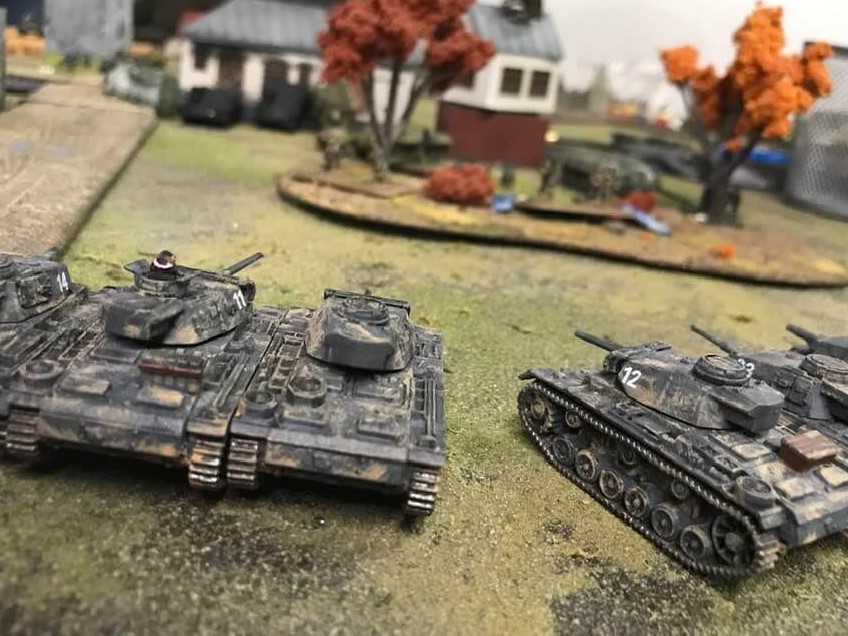 |
| Rob G played in the most games for the Germans, but MikeS had the best AVERAGE record for Germans (4.5 VPs per game). |
|
Lessons
I won’t repeat the vignette about one General’s opinion on lessons learned, but you can find it in BF’s archives: Firestorm Stalingrad- Phase I, Firestorm Stalingrad Phase II.
The point of the vignette is LESSONS only become LEARNED if you act on them.
Providing a structure for extra battles (who decides where to play, and limiting choices) made the decision about ‘first arrow’ critical, as we only had a couple extra battles, and all ended up in Prokhorovka. So it worked, after a fashion.
|
|
Being game attacker has a distinct influence on who wins the tactical battle. The Soviets won the toss on 9 battle arrows out of 15 and won control of 2 ‘extra’ battles, guiding them to the Prokhorovka track. The Germans only controlled 6 battle arrows and guided one spare battle to the Prokhorovka track. The Soviets ruthlessly exploited the advantage conferred by having the choice of ATTACK and MANEUVER in those opportunities. This produced 10 Soviet victories (and 2 more from American stand-ins). Of six German opportunities to control battle arrows and one extra battle guided to Prokhorovka, they lost two and had three draws, only converting two into victories (and winning their 3rd battle in Prokhorovka).
This, as well as recent tournament experience, led to a lot of discussion about the ‘weakness’ of the German lists out of the mid-war books. I think there is temptation of expensive units like the Ferdinand, Panthers and Tigers in combination with low total point values. The campaign format then took away the choice ‘ATTACK’ almost forcing the Germans into MANEUVER because their as-built list was unsuited for DEEP RESERVES and holding ground.
|
|
Having two or even three units affected by DEEP RESERVES made German players wary of ‘DEFEND’ choices, and so most games were ‘mobile battles’ with Germans on the defense without the benefit of minefields. Germans were then faced with tough choices in reserve situations, leaving them with either one big, powerful unit on table, and too few troops to man the line, or leaving the critical unit in reserve, and facing the onrushing Soviet horde with inadequate firepower. Needless to say COUNTERATTACK and BREAKTHRU played to Soviet strengths (Quantity has a quality all its own). In our next campaign, I’m going to address this by having players build two lists, and they’ll chose the list to play after finding out who owns the battle arrow.
|
|
Interestingly enough, the German midwar list that gave me the most trouble was one containing a Ferdinand, a MKIII company of (mostly) 50mm MKIII and Marders. No infantry at all.
The last LESSON was a need to schedule better. Having the participants distracted by other activities (Tournaments, holidays, etc.) kept us from playing more games, and that might have influenced the outcome.
|
Last Updated On Thursday, July 11, 2019
|
|
|